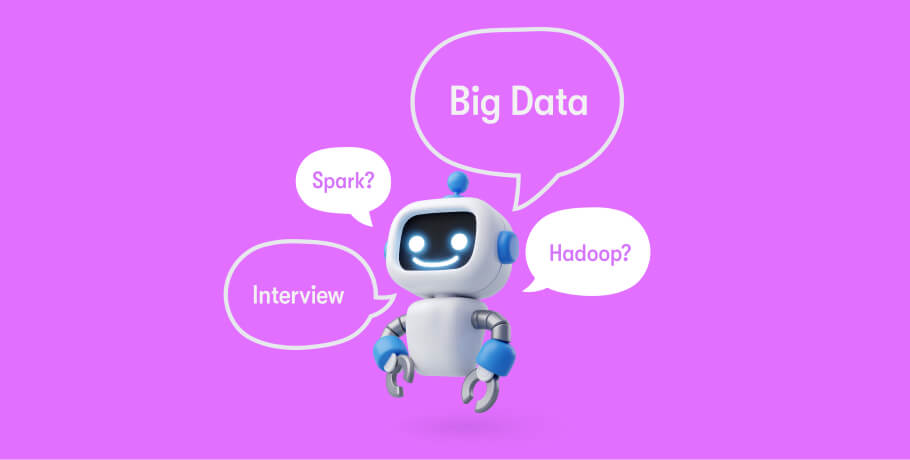The following article has been reviewed and verified by Juliana Diaz, Senior Software Engineer (Data Analytics & Visualization) at EPAM Anywhere. Many thanks, Juliana!
After exploring basic and behavioral data engineer interview questions, let’s dive into a selection of senior data engineer interview questions for experienced professionals commonly posed during the hiring process. Alongside each question, we will provide insightful answers that can help candidates prepare for their technical interview effectively, showcasing their expertise and suitability for senior-level positions in the dynamic and evolving field of data engineering.
apply for a senior data engineer job with EPAM Anywhere
Stop browsing jobs! Send us your CV and our recruiters will get back to you with the best-matching job in data engineering.
1. How do you collaborate with data scientists and analysts to understand their data requirements and provide them with the necessary data infrastructure and pipelines?
Collaborating with data scientists and data analysts is crucial for understanding their data requirements and providing the necessary data infrastructure and pipelines. Here are some key steps to facilitate effective collaboration:
- Understand the project goals and objectives. Engage with the data scientists and analysts to thoroughly understand their data requirements. Ask questions such as what types of data are needed, what variables are of interest, what specific metrics should be measured, how often data should be updated, and how the data will be used.
- Assess and evaluate existing data infrastructure. Document the data sources and systems already in use and evaluate their current data infrastructure. Identify any gaps, redundancies, and issues, and propose an ideal data architecture that best supports the data requirements.
- Develop data pipelines and ETL processes. Create stable and efficient data pipelines for ingesting, transforming, loading, and displaying data from multiple sources. Use established data-management best practices and leverage technologies such as Apache Spark and Presto to increase the speed and accuracy of the process.
- Monitor and troubleshoot data pipelines. Continuously monitor and troubleshoot data pipelines for errors and inconsistencies. Identify and resolve any issues and ensure that data integrity is maintained across the system.
- Test and deploy. Test the data pipelines and underlying data infrastructure before moving it into production. Ensure existing applications run smoothly and any new applications can use the data pipeline.
2. List and explain the design schemas in data modeling.
Various design schemas or approaches are used to structure and organize data in data modeling. Each schema has its own characteristics, benefits, and use cases. Here are four commonly used design schemas in data modeling:
- Relational Schema: Relational schema, also known as the entity-relationship (ER) model, is based on relational database management systems (RDBMS) principles. It organizes data into tables with rows and columns, where relationships between entities are established using primary and foreign keys. Relational schemas provide a clear structure, enforce data integrity through constraints, and allow for efficient SQL querying and data manipulation. They are widely used in transactional systems and structured data scenarios.
- Star Schema: The star schema is a schema design commonly used in data warehousing. It consists of a central fact table surrounded by dimension tables. The fact table contains measures or metrics, while dimension tables provide context and descriptive attributes related to the measures. The star schema simplifies complex data relationships, improves query performance, and supports efficient multidimensional analysis, such as OLAP (online analytical processing) operations. It is well-suited for analytical and reporting purposes.
- Snowflake Schema: The snowflake schema is an extension of the star schema. It represents a dimensional model where dimension tables are further normalized into multiple related tables. This normalization reduces data redundancy and allows for more efficient storage. The snowflake schema is beneficial in scenarios with highly hierarchical or deeply nested dimensions. However, it may introduce additional join operations compared to the star schema, potentially impacting query performance.
- NoSQL Schema: NoSQL databases, such as document-oriented databases (e.g., MongoDB) or key-value stores (e.g., Redis), have flexible schema designs that differ from traditional relational schemas. NoSQL databases often use a schema-less or schema-on-read approach, allowing for dynamic and flexible data structures. They can handle unstructured, semi-structured, or rapidly evolving data. NoSQL schemas are suitable for scenarios where data flexibility, scalability, and fast write/read operations are critical, such as in web applications or big data environments.
Each schema design has its own trade-offs, and the choice depends on the specific use case, data characteristics, scalability requirements, and querying needs. It is important to carefully consider factors such as data relationships, performance requirements, data consistency, and ease of maintenance when selecting a schema design for a particular data modeling scenario.
3. What strategies do you employ to optimize the performance of data pipelines and ensure scalability?
Optimizing the performance of data pipelines and ensuring scalability are crucial for efficient data processing. Here are some strategies employed to achieve these goals:
- Data partitioning: Partitioning data into smaller, manageable segments allows for parallel processing and reduces the load on individual components. Partitioning can be based on various criteria, such as time, geographic location, or a specific attribute. Distributing data across multiple nodes or processing units enables parallelization and improves pipeline performance.
- Caching and memoization: Implementing caching mechanisms can significantly improve performance by storing frequently accessed or computed data in memory. Caching reduces the need to repeat expensive computations or data retrieval operations, resulting in faster pipeline execution. Memoization, a form of caching, involves storing the results of computationally expensive operations for future reuse.
- Data compression: Compressing data can reduce storage requirements and enhance pipeline performance. Compressing data before storage or during data transfer consumes less disk space, resulting in faster data access and improved overall pipeline efficiency. However, it's essential to strike a balance between compression ratios and the overhead of decompression during data processing.
- Optimized data formats: Choosing efficient data formats, such as Parquet or ORC (Optimized Row Columnar), can significantly improve data processing performance. These columnar storage formats optimize data compression and allow for column pruning, where only the necessary columns are read during processing. This reduces disk I/O and speeds up data retrieval.
- Parallel processing and distributed computing: Leveraging frameworks such as Apache Spark or Apache Hadoop enables parallel data processing across multiple nodes or clusters. These frameworks provide scalability by distributing the workload across available resources, enhancing pipeline performance and accommodating large-scale data processing requirements.
- Query optimization: Optimizing data queries is crucial for pipeline performance. This involves techniques such as query rewriting, indexing, and query plan analysis to reduce unnecessary data scanning, minimize join operations, and leverage query optimization features provided by the underlying data processing engine or database.
- Monitoring and performance tuning: Implementing robust monitoring systems to track pipeline performance metrics helps identify performance bottlenecks and optimize resource utilization. Monitoring tools can capture key metrics like data throughput, latency, resource consumption, and system health, enabling data engineers to identify and resolve performance issues proactively.
- Horizontal scaling: Designing data pipelines with horizontal scalability in mind allows for seamless expansion as data volumes grow. This involves designing distributed architectures and leveraging cloud services or containerization technologies that support auto-scaling capabilities. Horizontal scaling ensures that the pipeline can handle increased workloads without compromising performance.
- Incremental processing: Adopting an incremental processing approach allows for processing only the new or changed data, rather than processing the entire dataset. By processing data incrementally, the pipeline can avoid unnecessary computations and reduce processing time, especially in scenarios where data is continuously streaming or arriving in batches.
By employing these strategies, data engineers can optimize data pipelines, improve performance, and ensure scalability to handle growing data volumes and processing demands effectively.
4. Describe your experience with data lakes and your challenges in managing and processing data within a data lake architecture.
I have worked extensively with data lakes and encountered various challenges in managing and processing data within a data lake architecture. Some key challenges include:
- Data governance: Data governance becomes complex in a data lake environment due to data's decentralized and schema-on-read nature. Ensuring data quality, defining data ownership, and maintaining metadata become crucial for effective data governance within a data lake.
- Data discovery and cataloging: With vast diverse data stored in a data lake, discovering and understanding the available data becomes challenging. Establishing a comprehensive data catalog and metadata management system helps discover and access relevant data assets.
- Data lineage and provenance: Tracking the origin, transformations, and data usage within a data lake is essential but can be difficult. Establishing data lineage and provenance mechanisms becomes crucial to understanding the data's history and credibility for regulatory compliance, auditing, and troubleshooting purposes.
- Data security and access control: Ensuring data security within a data lake is challenging due to the decentralized and flexible nature of the architecture. Implementing robust access control mechanisms, encryption, and data masking techniques is essential to protect sensitive data and prevent unauthorized access.
- Data lake architecture design: Designing an efficient and scalable data lake architecture requires careful consideration of factors like data partitioning, storage formats, data ingestion mechanisms, and data processing frameworks. Ensuring optimal performance and cost-effectiveness while accommodating diverse data sources and processing requirements can be complex.
- Data processing and performance: Processing large volumes of data within a data lake requires effective data processing techniques. Leveraging distributed processing frameworks like Apache Spark and optimizing data workflows are key to achieving efficient data processing and minimizing latency.
- Data integration and transformation: Integrating and transforming data from various sources into a cohesive structure poses challenges in a data lake environment. Ensuring compatibility, data consistency, and integrity across different data formats and structures requires robust data integration and transformation processes.
- Data lake maintenance and evolution: Data lakes are dynamic and continuously evolving. Regular maintenance activities such as data archiving, data lifecycle management, performance tuning, and infrastructure scaling are necessary to optimize and update the data lake infrastructure.
try a tech interview with us
Send us your resume and get invited to a technical interview for one of our available jobs matching your profile.
5. Discuss your considerations when designing a data warehouse schema.
When designing a data warehouse schema, several considerations come into play to ensure an efficient and effective structure. Here are some key considerations to remember:
- Identify the key business requirements for the data warehouse. It is essential to clearly understand what data needs to be included in the warehouse and why it is important.
- Choose the most appropriate data model that supports the business requirements. Different data models have their own advantages and disadvantages. Choosing the most appropriate data model is critical to a successful data warehouse schema design.
- Select the right database structure to store the data. Choose the most appropriate database structure for efficient data storage and retrieval.
- Determine the data flow between sources and targets. Identify the data extraction and loading techniques, transformation procedures, and any other data manipulation processes that are needed to provide timely, accurate data.
- Select the appropriate hardware infrastructure. The right hardware infrastructure like servers, storage, etc. can improve query performance and optimize for data retrieval and modification.
- Develop the schema in accordance with the data model selected. Make sure the schema is designed to accommodate any future changes and is efficient for data manipulation and storage.
- Use appropriate security measures. Protect the data stored in the warehouse from unauthorized access.
Apply for remote senior data engineer jobs at EPAM Anywhere
Once you’re done with these senior data engineer technical interview questions, we’ll be happy to see you join our global community of over 3,500 remote tech professionals in your role as a data engineer. In addition to the freedom of the remote-forever work style, you’ll contribute to top projects, get career mentoring, and have access to limitless free learning resources.
Browse our remote data engineer jobs or click the button below to use our ‘Find me a job’ service for matching your profile with the most relevant open job.

As Chief Editor, Darya works with our top technical and career experts at EPAM Anywhere to share their insights with our global audience. With 12+ years in digital communications, she’s happy to help job seekers make the best of remote work opportunities and build a fulfilling career in tech.
As Chief Editor, Darya works with our top technical and career experts at EPAM Anywhere to share their insights with our global audience. With 12+ years in digital communications, she’s happy to help job seekers make the best of remote work opportunities and build a fulfilling career in tech.
Explore our Editorial Policy to learn more about our standards for content creation.
read more























